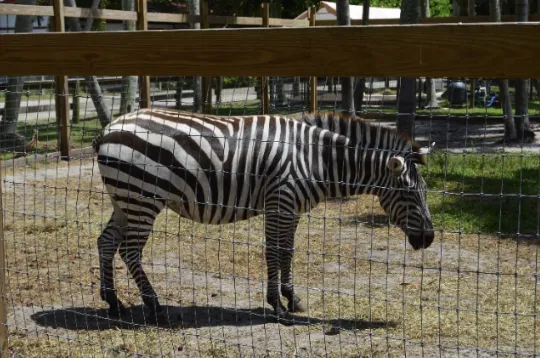
Grant Zebra
Guess which animal is the smallest member of the horse family, on average 4.5 feet high at the
shoulder and 8 feet long.
If you guessed the Grant Zebra, you are right!
Overview:
Grant Zebras (Equus quagga boehmi) are wild equids, believed to have originated from the savannas and grasslands of East Africa, particularly Kenya and Tanzania
They are closely related to other zebras, horses, and donkeys, all of which are part of the Equidae family
Grant Zebras are primarily found in open plains, where they have adapted to live in environments characterized by seasonal rains, vast grasslands, and predator presence. Their natural habitat includes savannas, grasslands, and sometimes woodlands.
Physical Description: Grant Zebras are medium-sized zebras, with a height ranging from 50 to 56 inches and typically weighing between 485 to 600 pounds. Grant Zebras have a distinctive black and white striped coat, which serves as camouflage and helps with thermoregulation.
Diet and Eating Habits: Grant Zebras are herbivores, primarily feeding on grasses. Their diet consists of grazing on pasturelands and consuming a variety of grasses. They have a simple stomach but a large cecum, which helps them digest fibrous plant material.
Behavior and Personality: Grant Zebras are known for their social behavior, making them popular subjects for wildlife observation. They are social creatures and prefer to live in herds, exhibiting strong bonds with other zebras. Grant Zebras communicate through various vocalizations, body language, and gestures to express emotions and maintain social order within the herd.
Domestication and Uses: Grant Zebras are wild animals and have not been domesticated. However, they play a crucial
role in their ecosystems by grazing, which helps maintain the balance of the grasslands. They are also valued for their striking appearance and are often featured in zoos and wildlife reserves for educational and conservation purposes.
Cultural Significance: Grant Zebras hold cultural significance for indigenous communities in East Africa, where they are admired for their beauty and role in the natural environment. In modern times, Grant Zebras have become symbols of wildlife conservation and biodiversity due to their role in maintaining healthy ecosystems.
Economic Importance: Grant Zebras contribute to the economy through ecotourism, as many tourists visit East Africa to see these iconic animals in their natural habitat. Wildlife reserves and national parks benefit from the presence of zebras, which attract visitors and support local economies.
Conservation Status: Grant Zebras are not considered endangered, and their populations are relatively stable due to conservation efforts and protected areas. However, they face threats from habitat loss and human-wildlife conflict. Conservation measures focus on habitat preservation and mitigating conflicts with humans.
Takeaway:
The Grant Zebra is a vital part of the ecosystem! Not only do these animals help maintain the balance of their habitats by grazing, but their presence also promotes ecotourism and supports local economies. Grant Zebras play a crucial role in preserving the biodiversity of East Africa’s grasslands.
